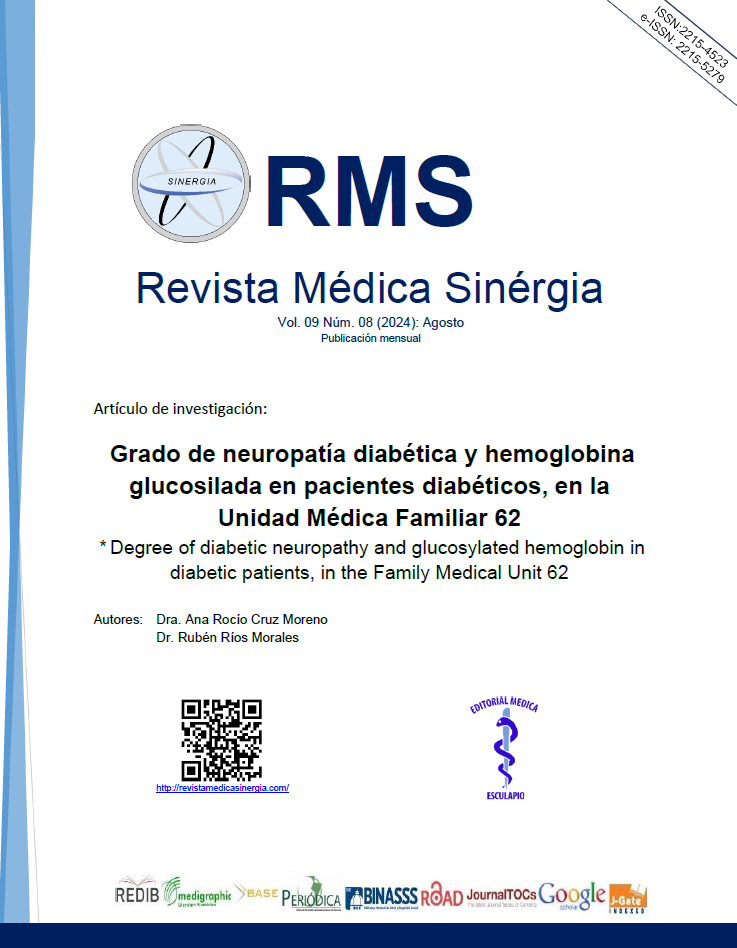Abstract
Background: Diabetic neuropathy is damage to nerve fibers derived from chronic hyperglycemia. In Mexico, 60% with type 2 diabetes mellitus have diabetic neuropathy and its frequency depends on the duration of diabetes. It is a cause of mortality and morbidity. since 50% of cases develop non-traumatic amputations. For this reason, my objective is to estimate the association between the degree of diabetic neuropathy and hemoglobin glycosylase. Methods: An observational, cross-sectional, prolective, analytical study was carried out in a sample of 154 patients, through non-probabilistic, non-randomized convenience sampling. Patients with a diagnosis of type 2 diabetes from the UMF 62 were included, applying the Semmens-Weinstein Test for the diagnosis of diabetic neuropathy with sensitivity of 97% and specificity of 83%, subsequently the degree of neuropathy was evaluated through the instrument. of Michigan with sensitivity of 79% and specificity of 94%, descriptive statistics were performed and in a second moment the Kruskall-Wallis ANOVA test with a (p=<0.05). Results: It was found that of the 154 patients, 3.8% remained in control and 16.23% (25 patients) remained uncontrolled, presenting grade 1 neuropathy, in grade 2 diabetic neuropathy 7.14% (11 patients) were within goals and the 72.72%, (112 patients) in lack of control, no patients with grade 3 neuropathy were obtained, it was evident that 89.02% are in lack of glycemic control and with peripheral sensory complications. It was found that there was no association between these two variables (p= 0.452).
Conclusions: It was concluded that in the Michigan Neuropathy test, in patients without amputations or Charcot's foot, it is not possible to stage severe neuropathy, so patients with amputations and musculoskeletal alterations in the feet must be included as an inclusive criterion.
Keywords
References
Vintimilla P, Giler Y, Motoche K. Diabetes mellitus tipo 2: Incidencias, Complicaciones y tratamientos actuales. Revista científica mundo de la investigación y el conocimiento. 2019;3:26-37. Disponible a partir de: https://recimundo.com/index.php/es/article/view/355.
Goyal R, Jialal I. Diabetes mellitus type 2. StatPearls. 2023 [cited Jun 23, 2023]. Available from: https://www.ncbi.nlm.nih.gov/books/NBK513253/.
Leal Ruiz E, Rodríguez Méndez L, Fusté Bruzain M. Complicaciones crónicas en pacientes con diagnóstico reciente de diabetes mellitus tipo 2. Medicentro (Villa Cl) [Internet]. 2019 [citado el 21 de junio, 2022];23(2):136–9. Disponible a partir de: http://scielo.sld.cu/scielo.php?script=sci_arttext&pid=S1029-30432019000200136.
Bondar A, Popa AR, Papanas N, Popoviciu M, Vesa CM, Sabau M, et al. Diabetic neuropathy: A narrative review of risk factors, classification, screening and current pathogenic treatment options (Review). Exp Ther Med [Internet]. 2021 [cited Jun 21, 2022];22(1):690. DOI: http://dx.doi.org/10.3892/etm.2021.10122.
Flores I, Cuevas Z, López R, Vázquez C. Detección de Neuropatía Diabética Periférica en Adultos Mayores de 60 Años en el Centro de Salud “México BID” de Colima, México. Archivos de la medicina. 2018;14:1-6. DOI: htt://dx- doi.org/10.3823/1399.
Rumora AE, Savelieff MG, Sakowski SA, Feldman EL. Disorders of mitochondrial dynamics in peripheral neuropathy: Clues from hereditary neuropathy and diabetes. Int Rev Neurobiol [Internet]. 2019;145:127–76. DOI: http://dx.doi.org/10.1016/bs.irn.2019.05.002.
Yan L-J. Redox imbalance stress in diabetes mellitus: Role of the polyol pathway. Animal Model Exp Med [Internet]. 2018 [cited Jun 22, 2022];1(1):7–13. DOI: http://dx.doi.org/10.1002/ame2.1200.
Nowotny K, Jung T, Höhn A, Weber D, Grune T. Advanced glycation end products and oxidative stress in type 2 diabetes mellitus. Biomolecules [Internet]. 2015;5(1):194–222. DOI: http://dx.doi.org/10.3390/biom5010194
Feldman EL, Callaghan BC, Pop-Busui R, Zochodne DW, Wright DE, Bennett DL, et al. Diabetic neuropathy. Nat Rev Dis Primers [Internet]. 2019;5(1):41. DOI: http://dx.doi.org/10.1038/s41572-019-0092-1.
Krishnasamy S, Abell TL. Diabetic gastroparesis: Principles and current trends in management. Diabetes Ther [Internet]. 2018;9(Suppl 1):1–42. DOI: http://dx.doi.org/10.1007/s13300-018-0454-9.
Raymond B, Steriovski J, Gillyard K, Yang C, Wu SC, Crews RT. Choosing a vibratory test to pair with Semmes Weinstein monofilament testing for evaluating lower extremity sensation in patients with diabetes: A comparison of three vibratory methodologies. J Diabetes Sci Technol [Internet]. 2020;14(1):8–15. DOI: http://dx.doi.org/10.1177/1932296819849478.
Costa T, Coelho L, Silva MF. Automatic segmentation of monofilament testing sites in plantar images for diabetic foot management. Bioengineering (Basel) [Internet]. 2022 [cited Jul 09, 2022];9(3):86. Available from: https://www.mdpi.com/2306-5354/9/3/86/htm.
Park JH, Kim DS. The necessity of the simple tests for diabetic peripheral neuropathy in type 2 diabetes mellitus patients without neuropathic symptoms in clinical practice. Diabetes Metab J [Internet]. 2018 [cited Jun 22, 2022];42(5):442–6. DOI: http://dx.doi.org/10.4093/dmj.2017.0090.
Arellano SA, Godínez ED, Hernández MB. Prevalencia de la neuropatía diabética en pacientes con diabetes mellitus tipo 2 en una clínica regional del Estado de México, Atención familiar [Internet]. 2017 [citado el 23 de julio, 2022];25:7-11. Disponible a partir de: https://www.revistas.unam.mx/index.php/atencion_familiar/article/view/62907.
Hussain A, Ahmad I, Khan MN, Zar A, Shahzad S. Peripheral neuropathy among patients with type 2 diabetes using michigan neuropathy screening instrument. J Postgrad Med Inst [Internet]. 2021 [citado el 22 de junio, 2022];35(1):7-11. Disponible a partir de: https://jpmi.org.pk/index.php/jpmi/article/view/2735
Haque F, Mamun R, Chowdhury M, Serkan K, Sawal A, et al. Performance Analysis of Conventional Machine Learning Algorithms for Diabetic Sensorimotor Polyneuropathy Severity Classification Using Nerve Conduction Studies. Comput Intell Neurosci [Internet]. 2022 [cited Jun 22, 2022]. 2022:1-13. DOI: http://dx.doi.org/10.1155/2022/9690940

This work is licensed under a Creative Commons Attribution-NonCommercial 4.0 International License.
Copyright (c) 2024 Array


